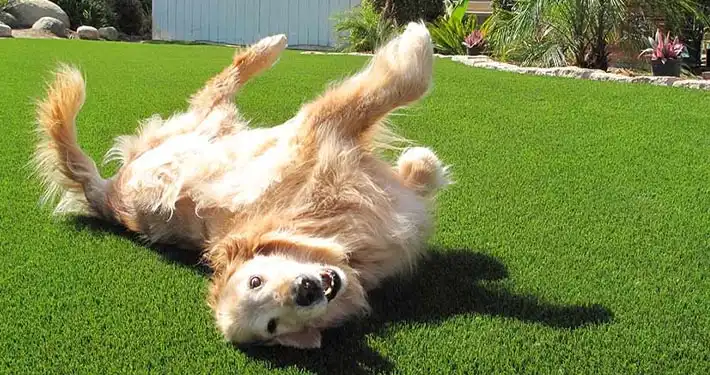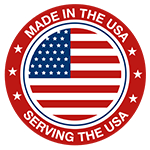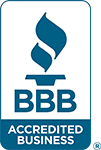How to Clean and Maintain Artificial Grass
The greatest benefits of artificial grass installation are the significant time and energy savings. Proper maintenance and care are key components to maximizing the life of your artificial grass products.
While the required maintenance is very minimal, the cleaner and more cared for your turf is, the longer it will last and more vibrant it will appear. It’s not uncommon for properly cleaned turf to last up to 20 years or longer.
A good goal would be to attend to your turf once a month if you have a putting green or lawn, and once or twice a week if you have pet turf.
Here’s everything you need to know about cleaning your artificial grass.
Tools Needed
There are a few items to have that will make caring for your synthetic turf an efficient process. Consider purchasing the following products: a garden hose, hose attachment, cleaning solution, a turf-safe rake, leaf blower, and pet deodorizer.
Garden hose
Although some may consider having a garden hose for large cleaning projects common sense, how to use the hose on your turf products may not be. With artificial grass, it is important to use a gentle sprayer setting because a high powered setting may damage the turf or disturb sand in-fill. Also, using cold water is best and be sure to spray your turf evenly.
Hose attachment
An attachment could be purchased to make spreading a cleaning solution or pet deodorizer onto your turf more efficient. Simply fill the container and connect it to any type of garden hose.
Turf rake
A turf rake is a great investment to safely remove debris from artificial turf products. This type of rake is used like a normal yard rake, but is made with materials safe for artificial grass. A turf-safe rake is made with flexible nylon tine, not metal or plastic, which can damage the turf.
Leaf blower
Another way to remove debris quickly from your artificial grass is to use a leaf blower. Be sure to use a low-powered setting to avoid any damage or creating more to clean.
Turf cleaning solution
A safe, simple and cost effective cleaning solution can be prepared at home. Mix equal parts distilled white vinegar and water to create an antimicrobial, non-toxic solution. The solution can be sprayed onto one specific area or over the entire surface.
Pet deodorizer
Pet waste on artificial grass should be removed daily to avoid bacteria and odor build up. A pet deodorizer can be sprayed onto one specific area and scrubbed or over the entire surface, to remove odors. Deodorizer can be used as needed, depending on pet use.
With these products, you will be able to efficiently clean and maintain your artificial turf. Remember, simple cleaning tools can extend the life of the turf and maximize your investment.
How to Clean Artificial Grass Lawn Turf

A few common products and simple steps can make cleaning and maintaining lawn & landscape turf a breeze.
This process is also how you clean and maintain putting green and playground turf.
Step 1: Remove excess debris
Use a leaf blower and/or turf rake to remove excess debris like leaves, dirt, or mulch. This should be done biweekly or as needed to ensure that your turf stays clean.
If using a leaf blower, be sure to set the speed at medium or low to avoid unpacking the sand infill. This is mostly important for putting greens or those applications where sand is filled on the top of the fibers.
Step 2: Spot clean
Spot clean your turf by spraying a solution equal parts vinegar and water onto the affected area or over the entire surface and rinsed with a hose. Another turf-safe store-bought solution may be used to spot clean. This should be done biweekly or as needed.
As simple as that. To clean synthetic lawn, putting green, & playground turf, remove the excess debris with a leaf blower then spot clean with a turf-safe solution and hose.
How to Clean Pet Turf

Pet turf cleaning & maintenance requires some additional steps to keep bacteria and odor from building up. Pet waste should be picked up as it happens, or at least daily to maintain cleanliness.
Follow these simple steps to keep your pet turf fresh and odor-free.
Step 1: Remove pet waste
In order to avoid odor and bacteria build up and stains on the turf, pet waste needs to be removed. If waste is left out for too long, it may start to decompose and affect the fibers of the turf.
Step 2: Remove excess debris
Use a leaf blower and/or turf rake to remove unwanted debris, like leaves, dirt or mulch. Similar to landscape turf and putting greens, use a lower setting with the leaf blower to ensure any infill stays in tact. Be sure the rake is safe for turf with nylon tine, not metal or plastic.
Step 3: Spot clean
Spot clean difficult areas with the water and vinegar solution and rinse with hose. Be sure to use a gentle setting on the hose to avoid damaging the fibers. Spot test first, before using any solution all over turf.
Step 4: Deodorize
Spray deodorizer over all turf to neutralize pet odors. Use the product’s sprayer function or attach the container to a garden hose for ease and efficiency. Refer to the product’s directions as to whether or not the deodorizer needs to rinsed off after application.
So cleaning artificial pet grass is similar to other turf, with the introduction of regular waste removal & deodorization. It’s also important to clean pet turf more frequently than other types of turf.
Cleaning & Maintaining Artificial Grass Turf – Simple but Important
The biggest benefit of artificial over real grass is the minimal maintenance. However, you still need to keep it clean in order to extend its life span and keep it looking and smelling fresh.
To clean artificial grass, simply keep it neat and tidy from debris using a leaf blower or turf rake, then spot treat any dirty spots with a turf-safe solution and garden hose.
With pet turf, be sure to regularly remove the waste and add a solution to neutralize pet waste odors.
Follow these simple turf cleaning process to keep your turf pristine.
Questions? Contact us.





